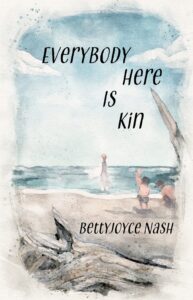EVERYONE HERE IS KIN
BOOK REVIEW

Using only thirty-eight words, the first sentence of Nash’s debut novel vividly describes two main characters, their behavior, beliefs, and financial status. Nash writes, “Naomi and I slogged through sand so hot it scalded our tender feet, lugging two rusted lounge chairs and a bag between us—her Coppertone tanning oil, my SPF 35; her Thermos of Pinot Grigio, my lemon water.”
Throughout the book, Nash writes with great economy, making every word count. By page three, we know Lucille is passionate about climate change and the environment. She cares deeply about the injustices of racism. She’s about to turn fourteen and was supposed to celebrate by going to Key West with her mother and young siblings. Lucille is eager to see the place before, in her words, “it becomes Atlantis.”
Lucille’s mother, Naomi, depends on her daughter to care for the two younger siblings. Naomi reneges on the Key West promise. Instead, the woman takes a detour to Boneyard Island, Georgia, where she plans to re-connect with a former high school flame, Tom. He is divorced and works as a developer. The detour angers and disappoints Lucille. She wonders if Tom is the kind of developer who “tears up paradise.”
While waiting for Tom to show up on the beach. Naomi pops a Xanax and then chases it with wine. Soon after they meet, Naomi and Tom take off on a trip to another island. They leave Lucille at the Palmetto Tourist Court to care for her younger brother and sister. A young veteran named Will manages the motel in exchange for housing. Broke, broken, and paralyzed by depression, Will earns a meager income by creating sculptures out of found wood. When he realizes Lucille and the children are on their own, he overcomes his hesitation to become involved and starts to include them in his rocky life.
Nash tells this story by alternating between Lucille in the first person and Will in the third person. This choice adds zip and sparkle to the prose. We readers dip into the bright, curious, remarkable mind of a complex and earnest teenager. We hear her dazzling thoughts and empathize her as she experiences a confusing and unsafe world. Nash’s use of third person from Will’s perspective provides a good counterpoint to Lucille. Will’s sections round out and expand the book. Will deals with the aftereffects of his combat experience, his self-doubt, how to eke out a living, how to care for Lucille and her siblings, and a complicated romance.
Nash’s gorgeous descriptions of Boneyard Island made me feel as if I could smell the low tide, see the Spanish moss, and sink my feet in the swampy mud. Nash creates images that are especially powerful in the last section of the book when Lucille and her elderly friend become lost in a thicket on the island during a devastating hurricane. Here’s an example of the writing, “Rain finally seeped inside the dense canopy…. The wind grew louder and cried like a person, like many, many people, marching, snapping branches, crashing trees, the wet woods halfway muting the violent noises.”
Throughout the novel, Nash creates unique ways to portray her character’s emotion. For example, Nash conveys Lucille’s disappointment about missing her trip to Key West by having her think: “I gulped salt air. It stung my raw heart.”
The novel contains several storylines. Is it possible that Will can get back on his feet? Will Naomi get treatment for her issues? Will Lucille make ever make it to Key West and more importantly (for this reader), will she find family to embrace her? Nash avoids wrapping up the story too tightly and at the same time, she delivers a satisfying ending.

Podcast: Play in new window | Download